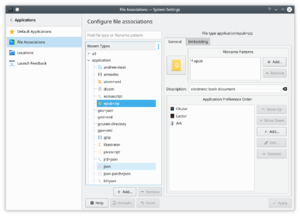System Settings/File Associations/de: Difference between revisions
Created page with "In der Liste im linken Fensterbereich finden Sie ein Suchwerkzeug und eine in Gruppen zusammengefasste Liste der bekannten Dateitypen. Um einen Dateityp zu finden, geben Sie e..." |
Created page with "{{Note|1=If you are searching for a file type based on its file name extension, you may need to enter the period character explicitly. For example, to find the file type for f..." |
||
| Line 14: | Line 14: | ||
In der Liste im linken Fensterbereich finden Sie ein Suchwerkzeug und eine in Gruppen zusammengefasste Liste der bekannten Dateitypen. Um einen Dateityp zu finden, geben Sie entweder einen Teil der Typbezeichung oder ein Suchmuster ins Eingabefeld oben ein. | In der Liste im linken Fensterbereich finden Sie ein Suchwerkzeug und eine in Gruppen zusammengefasste Liste der bekannten Dateitypen. Um einen Dateityp zu finden, geben Sie entweder einen Teil der Typbezeichung oder ein Suchmuster ins Eingabefeld oben ein. | ||
{{Note|1=If you are searching for a file type based on its file name extension, you may need to enter the period character explicitly. For example, to find the file type for file, whose name ends in ".c" ( | {{Note|1=If you are searching for a file type based on its file name extension, you may need to enter the period character explicitly. For example, to find the file type for file, whose name ends in | ||
Wenn Sie nach einem Dateityp anhand der Dateinamenserweiterung suchen, kann die explizite Eingabe des Punktes erforderlich sein. Um zum Beispiel den Dateityp für Dateien mit der Erweiterung ".c" zu finden (Quelltexte in der Programmiersprache C), geben Sie <code>*.c</code> oder einfach <code>.c</code> als Suchmuster ein - aber nicht <code>*c</code>. In diesem Kontext funktioniert das Stern-Zeichen ("*") nicht als Platzhalter.}} | |||
You can also browse the list of file types. Just expand the relevant category, and go through the list of file types that appear. Some of these list are very long, though. | You can also browse the list of file types. Just expand the relevant category, and go through the list of file types that appear. Some of these list are very long, though. | ||
Revision as of 16:27, 20 June 2015
 |
Einen vorhanden Dateitypen modifizieren, oder einen neuen hinzufügen |
Der Arbeitsbereich und individuelle Anwendungen erkennen unterschiedliche Dateiformate anhand des Dateityps. Auf diese Weise können unterschiedliche Dateien jeweils bestimmungsgemäß behandelt werden. Mit diesem Einstellungsdialog können Sie für jeden Dateityp festlegen, wie er zu behandeln ist. Er ermöglicht Ihnen auch die Definition neuer Dateitypen, auch können Sie die Erkennung eines bekannten Typs verändern.
Bekannte Dateitypen konfigurieren
In der Liste im linken Fensterbereich finden Sie ein Suchwerkzeug und eine in Gruppen zusammengefasste Liste der bekannten Dateitypen. Um einen Dateityp zu finden, geben Sie entweder einen Teil der Typbezeichung oder ein Suchmuster ins Eingabefeld oben ein.
You can also browse the list of file types. Just expand the relevant category, and go through the list of file types that appear. Some of these list are very long, though.
To modify a file type, locate it in the list of file types and click on its name. Now you will see two tabs in the right side of the dialog.
In the tab you can change the icon associated with this type of file by clicking the icon button in the top left of the tab. You can add or remove file name patterns in the list, thereby defining which files are recognized as having this type. The list in the bottom part of the tab names the applications that will show up in the context menu, when you right click on a file of this type. The first application in the list is the one that is used when you left click on the file.
The options in the tab affect how the file type is handled by Konqueror, when it is used as a file manager.
Adding new file types locally
To add a new file type click on the button below the list of file types in the left side of the window. That brings up a dialog where you should select a group from the dropdown list and enter a name in the text field. Then click the button to create your new file type.
Now you can edit the new file type in exactly the same way that you modified an existing file type.
Requesting new file types
The KDE software guesses filetypes using the shared-mime-info database, which is shared with many other software projects. To request a new file type to be added to the database, please, follow the instructions here.


